Tags
angel, Bernard of Clairvaux, Bruges, Burgundy, Carthusian, Charles the Bold, Chlothar, Christian, Dijon, Dole, Duchy of Burgundy, Duke of Merania, Emperor Friedrich Barbarossa, facsimile, Flanders, Flemish, Flemish Chronicles, France, German, Ghent, Girart de Roussillon, Holy Roman Empire, House of Burgundy, Hungary, illuminators, John the Fearless, King Boson, Louis XI, manuscript illumination, Margaret of York, Mary Magdalene, Master of Edward IV, Maximilian of Austria, Mechelen, miniatures, Montereau-Fault-Yonne, Oise, Olivier de la Marche, Philip the Bold, Philip the Fair, Poligny, rare books, Saint-Stephen of Besancon, Seine, spite, sword, Theodoric, Turks, tutor, workshop
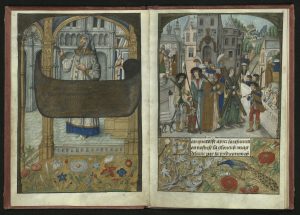
“Here follow some chronicles excerpted from some ancient registers and other teachings of certain ancient kings, princes and several holy persons from the very noble and ancient house of Burgundy.”
THE FLEMISH CHRONICLES OF PHILIP THE FAIR
Quaternio verlag Luzern, 2015
DC611 HB776 F5 2015
Facsimile. The Flemish Chronicles was produced in 1485/86 in Bruges for Philip, the heir to the House of Burgundy, who was just seven years old at the time. The Chronicles is a history of Burgundy illustrated with eleven large miniatures depicting historical events, idyllic nature scenes and scenes at court. The text is minimal, as would befit the beginning reading capacity of a child.
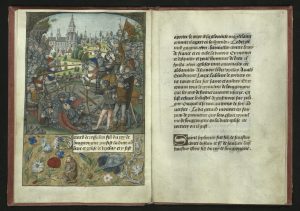
“Theodoric, King of Burgundy, defeated Chlothar, second King of this name of France, in battle in the year 605 after the resurrection of Our Lord. 30,000 men were then killed. During this battle an angel was seen holding a naked sword above the people. And at that time the said Theoderic conquered all the land situated between the rivers Seine and Oise, as it is written in detail in the chronicles of France.”
Like any children’s book, the images were intended to overtake the text. In this case, the images announce the importance of the dynasty Philip was to inherit. The Duchy of Burgundy ended with the death of Charles the Bold in 1477. Louis XI of France pounced on the Burgundian lands, but the economically powerful Flanders rebelled. Charles’ daughter Mary, in an effort to avoid catastrophe, married the son of the Holy Roman Empire, Maximilian of Austria, three months after her father’s death.
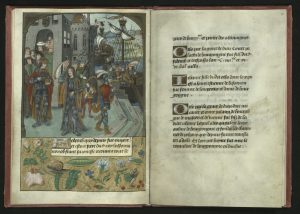
“Frederick, who since that time was Emperor, and who was a brother of the said King Boson, despite his young age recovered all the land of Burgundy and a part of the German lands.
Otto, by grace of God palatine count of Burgundy, was a son of the said Frederick, and he died in the year 1191, on the 26th day of June.
Jeanne, daughter of the said Otto, whose body lies in the church of Saint-Stephen of Besancon, was wife of the Emperor and lady of Burgundy.
Otto, by the grace of God Duke of Merania and palatine count of Burgundy, of Macon, and of Vienne was a son of the said Jeanne, who formerly claimed the Kingdom of Burgundy, and founded the canons of Poligny, who since then were transferred to Dole. And at that time, out of spite, the Kingdom of Burgundy was turned into a Duchy.”
Their son, Philip, was born on June 22 in Bruges. Mary died in an accident in 1482.
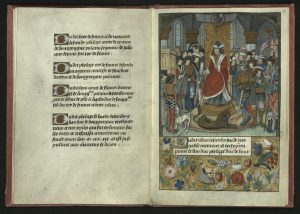
“From the said Philip the Bold descended John the Fearless Duke of Burgundy, most victorious and most Christian prince who fought the Turks in Hungary, and died at Montereau-Fault-Yonne in the year 1419. His tomb is in the Carthusian church at Dijon.”
The Flemish territories refused to recognize Maximilian as regent for his son. Ghent and Bruges rebelled. In 1485 Maximilian took Philip to Mechelen, where his grandmother, Margaret of York, raised him.
This chronicle, written and produced for Philip, featured a century of his Burgundian ancestors. This is an unusual book for its time, made especially for a child. The chronicler, Olivier de la Marche, was Philip’s tutor. The chronicle sets the Burgundian throne within a thousand year-old history, beginning in 14CE and ending just after the death of Philip’s mother. In this setting, the Burgundian ancestors were placed alongside Mary Magdalene (who purportedly baptized the first Burgundian king), the knight Girart de Roussillon, Bernard of Clairvaux, Emperor Friedrich Barbarossa and the Burgundian dukes from Philip the Bold on.
Flanders was a bevy of wealthy commercial cities at this time. Bruges and Ghent had a concentration of talented and well-funded illuminators. These cities became the center of European manuscript illumination in the second half of the fifteenth century. In this highly competitive atmosphere, Master of Edward IV operated a flourishing workshop. One of his assistants created the miniatures and border art for The Flemish Chronicles.
Facsimile edition of seven hundred and forty copies, sixty of which are hors de commerce. Rare Books copy is no. 134.

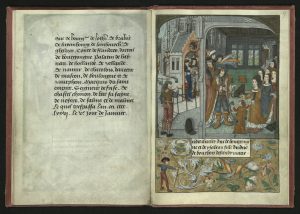
You must be logged in to post a comment.